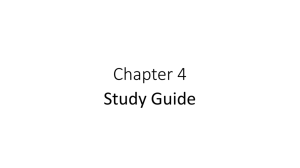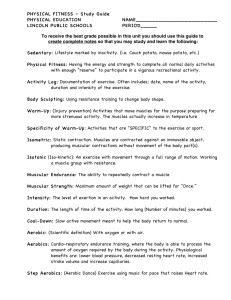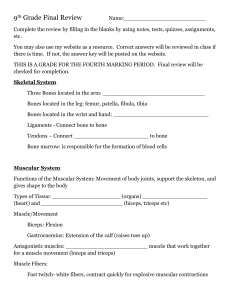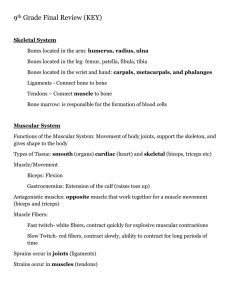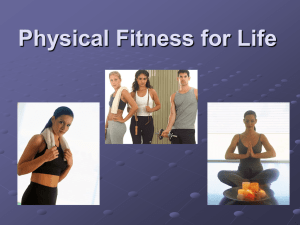Physical Fitness for Life
advertisement
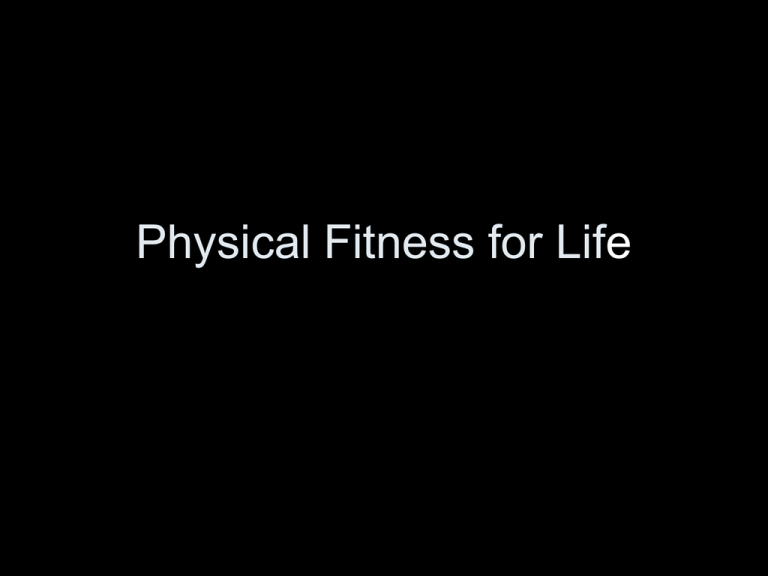
Physical Fitness for Life Benefits of Being Physically Active • Certain amount of physical activity everyday keeps you healthy and lowers risk of disease. • Modern conveniences have reduced the need to be physically fit. • Exercise can be very easy and formal or informal. • Also doing everyday activities can keep a person fit and healthy. Physical Benefits • Exercise leads to many improvements in the body: • Heart and Lungs get stronger allowing more blood and oxygen to circulate. • Blood vessels are kept strong and healthy • Ratio of muscle mass to fat mass is maintained • Metabolism is increased. Metabolism is the rate at which your body converts food energy into energy that keeps you alive. Mental and Social Benefits • Positive effects on feelings of depression anxiety, and reduces stress levels. • Release of endorphins, which are chemicals in the body that makes a person feel good and happy. • Increased self-esteem • Socialize with people with the same interest. Five Components of HealthRelated Fitness • 1.Muscular Strength-amount of force that a muscle can apply in a given contraction. When lifting weights the muscle cells become larger thus increasing overall strength. • 2.Muscular Endurance-the ability of the muscles to keep working over a period of time. Muscular strength and endurance are closely related; as one improves so does the other. Five Components Cont. • 3.Cardiorespitory Endurance-the ability of your heart, blood vessels, lungs, and blood to deliver oxygen and nutrients to all of your body parts. This is considered the most important component b/c as the endurance increases then the heart beats slower and stronger. Resting heart rate-the number of times the heart beats per minute while at rest. Recovery time-the amount of time it takes fro the heart to return to RHR. Anaerobic Activity-muscle cells produce energy without oxygen. Aerobic Activity-muscle cells use oxygen to produce energy for movement Five Components Cont. • 4.Flexibility-ability of joints to move through their full range of motion. Having good flexibility is important b/c lack of use can cause joints to become stiffer. • 5.Body Composition-ratio of lean body tissue to body-fat tissue. Women naturally have more body fat than men. Physical Activity is for Everyone • By beginning good habits early in life a person can delay or even prevent some chronic diseases. • Strength training at an old age will help maintain bone density and prevent osteoporosis. • Exercise for people with asthma is part of the treatment plan. Gaining fitness helps decrease the severity of asthma symptoms. Planning Your Fitness Program • 1. Know of all health problems that you might have. Consult a doctor before you start. • 2.Make sure you are healthy enough to start a fitness program. Go get a physical • 3. Choose activities that you enjoy • 4. How much will it cost to do your fitness program. Designing a Fitness Program • 1.Determine Your RHR: Take your RHR three mornings in a row to get an average RHR Count your pulse for 60 sec. Average RHR for an adult is 50-80;teens are a little higher. • 2.Calculate Your Target Heart Rate Zone THRZ is normally b/t 60 and 85 percent of your maximum heart rate. Students will do this on pg. 134. Designing Fitness Program Cont. • Set Goals Set long and short term goals Choose ones that you want to achieve b/c this will lead to motivation • Keep track of your progress FITT Model • F- Frequency, how many times a week. 3-5 times a week. • I - Intensity, how hard. MHR 85%=20mins. 50-60% MHR=60mins • T- Time, long. 20-60mins. Higher intensity=Less Time • T- Type. Type-any aerobic activity that keeps heart rate within your THRZ. Develop Muscles • F-weight train 2-3 times a week • I-weight that you can lift 8-12 reps. Each set (which is a rest period) should be between 1-3 mins. long. • T-total workout should be from 30-60 mins • T-Anaerobic activities. Muscular endurance lift lighter weights. Muscular strength lift heavier weights. Exercising the Safe Way • 1.Conditioning-lack of conditioning can put strain on muscles and joints and can also lead to injury. Progressive Overload Principle-the physical demands or overload placed on the body will cause the body to develop in response to the overload. Overload must progress or increase over time. 2. Warm Up and Cool Down-Warming up increases blood flow to muscles, stretches your muscles and ligaments and increases heart rate. Cool down prevents next day soreness. Exercising the Safe Way Cont. • Avoid Dehydration-Dehydration is when the body has lost more water than has been taken in. Drinking water maintains the blood volume, circulation and sweating. • Avoid Overtraining • Choose Correct Equipment and Clothing Treating Minor Sports Injuries • Use the RICE principle: • R-Rest • I-Ice. Leave ice on injury for no longer than 15-20 mins. • C-Compression. Wrap a bandage around the affected area • E-Elevation. Elevate the injury above heart level. Dietary Supplements • Supplements that are not regulated by the FDA. • Makers of the product can make claims about their product without any scientific proof. • Claims of dietary supplements improving performance is often based on improvements from training. • Creatine is produced naturally in the pancreas and liver and is a natural muscle builder. Creatine is also not regulated by the FDA. • Have students look at Table 3 pg. 144 Anabolic Steroids • Def.-synthetic version of the male hormone testosterone. • Doctors use small doses to treat some conditions such as muscle disease, kidney disease, and breast cancer. • Health Problems for both males and females. • Females-excessive growth of facial and body hair, baldness, increased risk of cancer, and menstrual problems • Males-aggressive behavior, severe acne, testicular shrinkage, stunt growth in teens • More that 1million male and female athletes are or have taken steroids.



